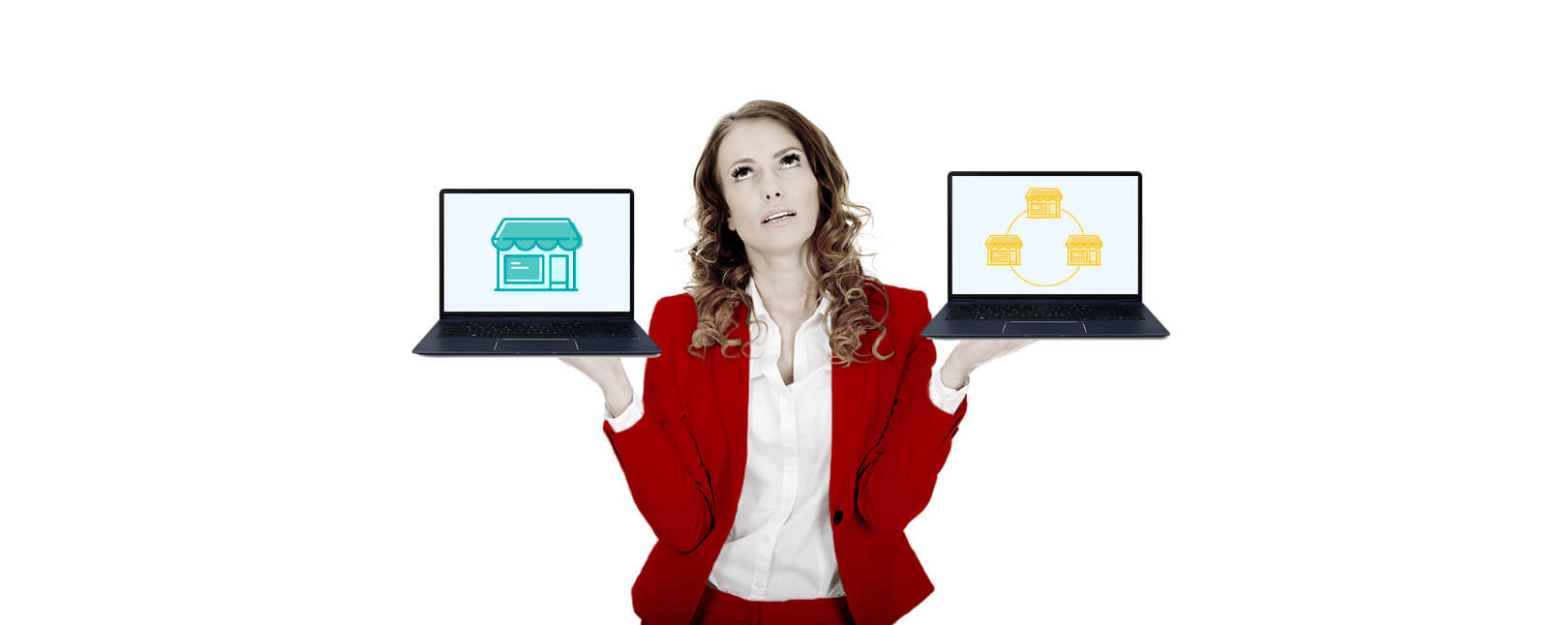eCommerce Site or Online Marketplace: What’s the Right Choice for Your Business?
You’re probably familiar with online marketplaces, at least to some degree. If you’ve ever bought something on a site like eBay or Etsy, or through a third-party seller on Amazon, you’ve shopped at an online marketplace.
A lot of consumers think of online marketplaces operating in a manner similar to a typical eCommerce store, but the two are actually very different.
Choosing between the two can be a pressing question if you’re a merchant looking to launch a new business. You may be wondering: should I create my own eCommerce site? Should I operate through a marketplace? What makes the most sense?
In today’s post, we’ll take a look at these two models, and examine the advantages—and disadvantages—of each.
What’s the Difference Between an eCommerce Site and a Marketplace?
First, let’s begin by explaining each of these terms.
An eCommerce site is an online store through which a single seller conducts business. The owner of the site manages inventory, invoices customers, and markets products. You can’t register as a third-party seller on another merchant’s eCommerce site, just as you wouldn’t be allowed to walk into a brick-and-mortar store and start selling your own merchandise.
In contrast, a marketplace is a site that allows third-party sellers to conduct business. Sellers can run their own “shops,” meaning they manage inventory, invoice customers, and market products. However, they conduct these activities through the marketplace—which serves as a platform for the sellers—rather than building their own eCommerce platform.
It’s similar to a physical market: the operators provide vendor space but don’t actually sell anything themselves. The marketplace may serve as a third-party arbiter if a problem arises between a buyer and a seller, but they remain largely hands-off.
As we alluded to earlier, though, some sites like Amazon are eCommerce retailers who also operate a marketplace on their platform. While they’re closely integrated, these marketplace sellers operate under different rules, and their orders are typically not fulfilled by the site. The seller is still responsible for their own operations, just like any other marketplace.
Chargebacks are a Problem…No Matter the Platform.
Chargebacks911 are the industry’s leading experts in chargeback management.

The “Pros” and “Cons”: eCommerce Sites
With an eCommerce site, the primary advantage is that you have total control over every aspect of the business.
You can design your own site, produce your own graphics and marketing materials, and create your own content. You can optimize your site using keywords that best reflect the products that you sell. Also, you can create your own URL for the site, which allows for better brand exposure and recognition.
Of course, the freedom afforded by running your own site is counterbalanced by increased responsibility. You have to pay to build and maintain the site, as well as create all of the marketing assets we just discussed.
You also don’t have a built-in customer base; instead, you have to grow one by driving traffic to your site. While some sellers get lucky with early exposure or have connections to influential figures, most have to grow an audience organically. This will require a substantial investment in marketing, with no guarantee of success.
Finally, you have to conduct all of your operations yourself. You have to handle processes like order fulfillment, inventory management, and customer service all on your own. You can contract with a third-party to handle certain aspects of your operations; ultimately, however, you’re still responsible for everything.
The “Pros” and “Cons”: Online Marketplaces
One of the greatest assets of selling through an online marketplace is that, in many cases, you don’t have to work as hard to attract eyes.
Let’s say you’re selling through a well-established platform like Amazon or eBay. If so, you won’t have to devote nearly as much time or money to running a website or conducting processes like search engine optimization (SEO) and content marketing to draw in traffic. These massive platforms already have a built-in audience: as long as you can craft strong product descriptions, your customers will find you.
Online marketplaces also provide a degree of support that you won’t get if you’re on your own. With product returns, for instance, many marketplaces have streamlined, simplified processes to facilitate quick and easy returns. This substantially cuts down on the resources you need to devote to customer service. Your platform may even insulate you against some customer disputes.
On the downside, marketplaces remove a lot of that freedom you’d enjoy as an eCommerce merchant. You won’t have much control over your platform, nor will you be able to create specialized product pages.
You also have to abide by the rules established by the marketplace, which may not be in your best interests. In 2017, for example, Amazon introduced a major overhaul of their refund policies for marketplace sellers. This resulted in an uproar among sellers, who claimed that the new policies would “crush” their businesses. At the end of the day, though, marketplace sellers had no choice but to either comply with Amazon’s policies or leave the platform.
Marketplaces can be a good option for brands looking to break into eCommerce. As the business grows, though, the limitations of the platform can chafe more and more.
What About Both?
So, there are positives and negatives to consider no matter which platform you choose. Of course, there may also be a third option: both.
Spreading your resources across multiple platforms may not be a wise move for businesses that are just starting out. However, a number of established brands operate their own eCommerce sites, while also maintaining a presence on one (or more) marketplaces. Doing so would allow you to capitalize on the built-in traffic of the marketplace, while also having an independent operation elsewhere.
If you did eventually expand to a multi-platform strategy, you’d want to ensure you’re attracting different buyers to each location. This demands very detailed and intelligent tracking capabilities that would allow you to spot such trends among buyers. Otherwise, you risk cannibalizing your own sales, rather than acquiring new customers.
Also, you need to consider vulnerabilities that transcend platforms. Customer disputes, for instance, could be a problem regardless of how you opt to conduct business.
Many online marketplaces provide some measure of fraud protection and support for sellers. However, this wouldn’t offer any defense against friendly fraud, which is believed to represent roughly 60-80% of all disputes. These illegitimate chargebacks sap billions of dollars in revenue from merchants every year, in addition to added fees and longer-term threats to business operations.
Regardless of the platform you ultimately choose, you need to consider all your points of vulnerability. Otherwise, you could end up seeing your hard-earned cash disappear.












